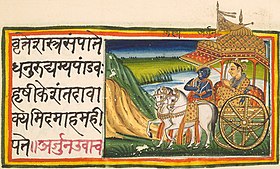|
تضامنًا مع حق الشعب الفلسطيني |
اللغة السنسكريتية
| ||||
|---|---|---|---|---|
(فوق) مخطوطة سنسكريتية مصورة من القرن التاسع عشر [1] (أسفل) طابع الذكرى 175 لثالث أقدم كلية سنسكريتية ، كلية اللغة السنسكريتية ، كلكتا. أقدمها هي كلية بيناريس السنسكريتية ، التي تأسست عام 1791. | ||||
| النسب | ||||
| تعديل مصدري - تعديل | ||||
السنسكريتية ( ؛ باللغة السنسكريتية: संस्कृत [2][3] اسميًا : संस्कृतम् (سَمسكرتَم) [4]) هي لغة قديمة في الهند وهي لغة طقوسية للهندوسية، والبوذية، والجاينية.[5][6][7] لها موقع في الهند وجنوب شرق آسيا مشابه للغة اللاتينية واليونانية في أوروبا في القرون الوسطى، وقد لاحظ هذا الشبه العالم اللغوي ويليام جونز حيث كان يعمل قاضياً هناك، ولهذه اللغة جزء مركزي في التقليد الهندوسي. السنسكريتية هي إحدى الاثنتين وعشرين لغة رسمية للهند. تُدرّس في الهند كلغة ثانية. كما أن بعض البراهمنيين -وهم الوعاظ من الطبقة العالية- يعتبرونها لغتهم الأم.
| جزء من سلسلة مقالات حول |
| الثقافة الهندية |
|---|
 |
| التاريخ • المجموعات العرقية [English] • الدين • المطبخ • الرياضة |
| بوابة الهند |
لقد كانت اللغة السنسكريتية وما زالت في الهند في المعابد فيسمح فقط لكهنة البراهما بقراءة النصوص السنسكريتية، أما في الماضي فتواجدت في الأدب الهندي: أدب لغتي البالي والبراكريت، الأدب الدرافيدي الباكر، الأدب البنغالي. وغيره من الآداب والشعر الديني المستوحى.
تشير السنسكريتية عمومًا إلى العديد من اللغات الهندية الآرية القديمة. أكثرها قديمة هي الفيدية السنسكريتية الموجودة في ريجفدا، وهي مجموعة من 1028 ترنيمة مؤلفة بين 1500 قبل الميلاد و 1200 قبل الميلاد من قبل القبائل الهندية الآرية المهاجرة شرقا مما هو اليوم أفغانستان عبر شمال باكستان وإلى شمال الهند.[8][9] تفاعلت اللغة السنسكريتية الفيدية مع اللغات القديمة الموجودة مسبقًا في شبه القارة الهندية، واستوعبت أسماء النباتات والحيوانات التي تمت مواجهتها حديثًا ؛ بالإضافة إلى ذلك، أثرت اللغات الدرافيدي القديمة على علم الأصوات والنحو السنسكريتية.[10] يمكن للسنسكريتية أيضًا أن تشير بشكل أكثر تحديدًا إلى اللغة السنسكريتية الكلاسيكية، وهي شكل نحوي دقيق وموحد ظهر في منتصف الألفية الأولى قبل الميلاد وتم تدوينه في أشمل القواعد النحوية القديمة. كتب كاليداسا (أعظم كاتب مسرحي في اللغة السنسكريتية)، باللغة السنسكريتية الكلاسيكية، وتم وصف أسس الحساب الحديث لأول مرة في اللغة السنسكريتية الكلاسيكية.[11] تم تأليف الملحمتين السنسكريتية الرئيسيتين، مهابهاراتا ورامايانا في مجموعة من سجلات الحكايات الشفوية تسمى ملحمة سنسكريتية والتي كانت تُستخدم في شمال الهند بين 400 قبل الميلاد و 300 م ، ومُعاصرة تقريبًا للغة السنسكريتية الكلاسيكية.[12] في القرون التالية، أصبحت اللغة السنسكريتية مُرتبطة بالتقاليد، وتوقف تعلمها كلغة أولى، وتوقفت في النهاية عن التطور كلغة حية.[13]
التاريخ
الأصل والتنمية

تنتمي اللغة السنسكريتية إلى عائلة اللغات الهندو أوروبية. وهي واحدة من أقدم ثلاث لغات قديمة موثقة نشأت من لغة جذر مشتركة يشار إليها الآن باسم لغة هندو أوروبية البدائية :
- الفيدية السنسكريتية (حوالي 1500-500 قبل الميلاد).
- اليونانية الميسينية (حوالي 1450 قبل الميلاد) واليونانية القديمة (750 - 400 قبل الميلاد).
- الحثية (حوالي 1750-1200 قبل الميلاد).
الصور
-
مخطوطة بالخط شارادا (القرن 17)
-
مخطوطة على أوراق النخيل في (القرن 11)
انظر أيضاً
المراجع
- ^ Mascaró، Juan (2003). The Bhagavad Gita. Penguin. ص. 13 ff. ISBN:978-0-14-044918-1. مؤرشف من الأصل في 2022-01-21.
The Bhagawad Gita, an intensely spiritual work, that forms one of the cornerstones of the Hindu faith, and is also one of the masterpieces of Sanskrit poetry. (from the backcover)
- ^ Cardona، George؛ Luraghi، Silvia (2018). "Sanskrit". في Bernard Comrie (المحرر). The World's Major Languages. Taylor & Francis. ص. 497–. ISBN:978-1-317-29049-0.
Sanskrit (samskrita- 'adorned, purified') ... It is in the رامايانا that the term saṃskṛta- is encountered probably for the first time with reference to the language.
- ^ Wright، J.C. (1990). "Reviewed Works: Pāṇini: His Work and Its Traditions. Vol. I. Background and Introduction by George Cardona; Grammaire sanskrite pâninéenne by Pierre-Sylvain Filliozat". Bulletin of the School of Oriental and African Studies, University of London. Cambridge University Press. ج. 53 ع. 1: 152–154. DOI:10.1017/S0041977X0002156X. JSTOR:618999. مؤرشف من الأصل في 2022-01-21.
The first reference to "Sanskrit" in the context of language is in the رامايانا, Book 5 (Sundarkanda), Canto 28, Verse 17: अहं ह्यतितनुश्चैव वनरश्च विशेषतः // वाचंचोदाहरिष्यामि मानुषीमिह संस्कृताम् // १७ // هانومان says, "First, my body is very subtle, second I am a monkey. Especially as a monkey, I will use here the human-appropriate Sanskrit speech / language.
- ^ Apte، Vaman Shivaram (1957). Revised and enlarged edition of Prin. V.S. Apte's The practical Sanskrit-English Dictionary. Poona: Prasad Prakashan. ص. 1596. مؤرشف من الأصل في 2022-04-07.
from संस्कृत saṃskṛitə نعت مشتق من الفعل: Made perfect, refined, polished, cultivated. -तः -tah A word formed regularly according to the rules of grammar, a regular derivative. -तम् -tam Refined or highly polished speech, the Sanskṛit language; संस्कृतं नाम दैवी वागन्वाख्याता महर्षिभिः ("named sanskritam the divine language elaborated by the sages") from كافيادارسا.1. 33. of Daṇḍin
- ^ "PIL seeks minority status for Sanskrit". The Financial World. 15 أكتوبر 2012. مؤرشف من الأصل في 9 مايو 2013. اطلع عليه بتاريخ 10 نوفمبر 2012.
- ^ Jack Goody (1987). The Interface Between the Written and the Oral. Cambridge University Press. ص. 110–121. ISBN:978-0-521-33794-6. مؤرشف من الأصل في 2017-02-25.
- ^ "Sanskrit Personal Names and their Japanese Equivalents"نسخة محفوظة 30 March 2015 at WebCite نسخة محفوظة 09 يوليو 2017 على موقع واي باك مشين.
- ^ Lowe، John J. (2015). Participles in Rigvedic Sanskrit: The syntax and semantics of adjectival verb forms. Oxford University Press. ص. 1–2. ISBN:978-0-19-100505-3. مؤرشف من الأصل في 2022-03-21.
It consists of 1,028 hymns (suktas), highly crafted poetic compositions originally intended for recital during rituals and for the invocation of and communication with the Indo-Aryan gods. Modern scholarly opinion largely agrees that these hymns were composed between around 1500 BCE and 1200 BCE, during the eastward migration of the Indo-Aryan tribes from the mountains of what is today northern Afghanistan across the Punjab into north India.
- ^ Witzel، Michael (2006). "Early Loan Words in Western Central Asia: Indicators of Substrate Populations, Migrations, and Trade Relations". في Victor H. Mair (المحرر). Contact And Exchange in the Ancient World. University of Hawaii Press. ص. 158–190, 160. ISBN:978-0-8248-2884-4.
The Vedas were composed (roughly between 1500-1200 and 500 BCE) in parts of present-day Afghanistan, northern Pakistan, and northern India. The oldest text at our disposal is the Rgveda (RV); it is composed in archaic Indo-Aryan (Vedic Sanskrit).
- ^ Shulman، David (2016). Tamil. Harvard University Press. ص. 17–19. ISBN:978-0-674-97465-4. مؤرشف من الأصل في 2022-04-07.
(p. 17) Similarly, we find a large number of other items relating to flora and fauna, grains, pulses, and spices—that is, words that we might expect to have made their way into Sanskrit from the linguistic environment of prehistoric or early-historic India. ... (p. 18) Dravidian certainly influenced Sanskrit phonology and syntax from early on ... (p 19) Vedic Sanskrit was in contact, from very ancient times, with speakers of Dravidian languages, and that the two language families profoundly influenced one another.
- ^ Glenn Van Brummelen (2014). "Arithmetic". في Thomas F. Glick؛ Steven Livesey؛ Faith Wallis (المحررون). Medieval Science, Technology, and Medicine: An Encyclopedia. Routledge. ص. 46–48. ISBN:978-1-135-45932-1.
The story of the growth of arithmetic from the ancient inheritance to the wealth passed on to the Renaissance is dramatic and passes through several cultures. The most groundbreaking achievement was the evolution of a positional number system, in which the position of a digit within a number determines its value according to powers (usually) of ten (e.g., in 3,285, the "2" refers to hundreds). Its extension to include decimal fractions and the procedures that were made possible by its adoption transformed the abilities of all who calculated, with an effect comparable to the modern invention of the electronic computer. Roughly speaking, this began in India, was transmitted to Islam, and then to the Latin West.
- ^ Lowe، John J. (2017). Transitive Nouns and Adjectives: Evidence from Early Indo-Aryan. Oxford University Press. ص. 58. ISBN:978-0-19-879357-1. مؤرشف من الأصل في 2022-04-07.
The term 'Epic Sanskrit' refers to the language of the two great Sanskrit epics, the Mahābhārata and the Rāmāyaṇa. ... It is likely, therefore, that the epic-like elements found in Vedic sources and the two epics that we have are not directly related, but that both drew on the same source, an oral tradition of storytelling that existed before, throughout, and after the Vedic period.
- ^ Lowe، John J. (2017). Transitive Nouns and Adjectives: Evidence from Early Indo-Aryan. Oxford University Press. ص. 53. ISBN:978-0-19-879357-1. مؤرشف من الأصل في 2022-04-07.
The desire to preserve understanding and knowledge of Sanskrit in the face of ongoing linguistic change drove the development of an indigenous grammatical tradition, which culminated in the composition of the Aṣṭādhyāyī, attributed to the grammarian Pāṇini, no later than the early fourth century BCE. In subsequent centuries, Sanskrit ceased to be learnt as a native language, and eventually ceased to develop as living languages do, becoming increasingly fixed according to the prescriptions of the grammatical tradition.
| في كومنز صور وملفات عن: اللغة السنسكريتية |





